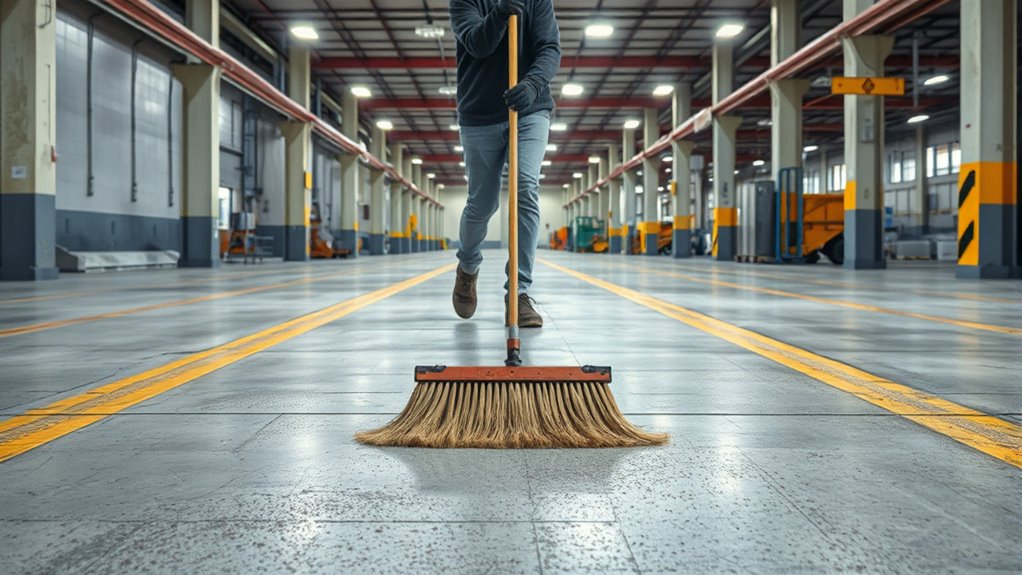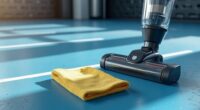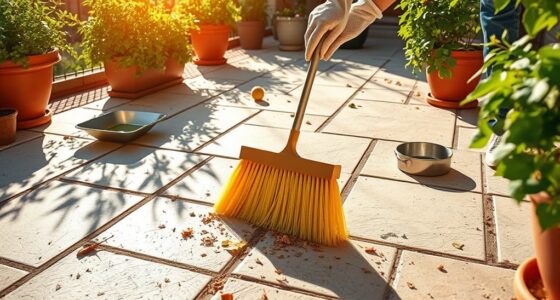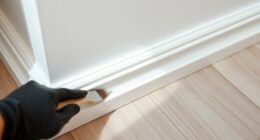To sweep concrete floors faster, plan systematic lanes that run straight and overlap by about 10-20% to prevent missed debris. Start from a corner and work toward a designated exit point, ensuring you finish there for efficient debris collection. Keep a steady pace and wide sweeping motions to cover more ground efficiently. Adjust your approach as needed for obstacles, and paying attention to lane layout, overlaps, and exit positions will boost your speed and thoroughness — learn more for even better results.
Key Takeaways
- Plan straight, overlapping lanes with 10-20% overlap to ensure complete coverage and reduce missed debris.
- Start sweeping from a corner toward an exit point for efficient debris collection and minimized cross-contamination.
- Position sweepers to finish at designated exits, streamlining debris removal and preventing backtracking.
- Maintain a steady, wide sweeping motion at a consistent pace to cover more area quickly.
- Adjust lane width and overlap in tight spaces or obstacles to maintain speed without sacrificing thoroughness.
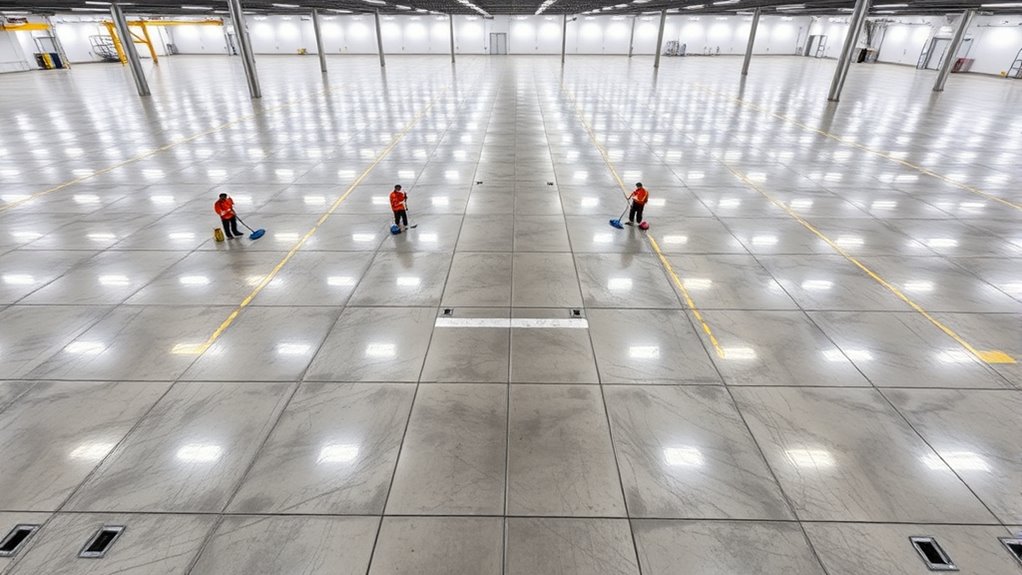
Are you tired of spending endless hours sweeping concrete floors? If so, you’re not alone. Many struggle to clean large surfaces efficiently, wasting valuable time and effort. The key to sweeping faster lies in understanding the significance of proper lanes, overlap, and exit points, but equally essential are dust control and equipment maintenance. Implementing effective strategies in these areas can dramatically cut down cleaning times while keeping your workspace safe and clean.
First, focusing on dust control is essential. When sweeping, dust can become airborne, reducing visibility and creating health hazards. To address this, use sweeping equipment equipped with dust control features, such as dust skirts or vacuums attached to brooms. These help contain dust, preventing it from spreading across the area and slowing down your progress. Regularly maintaining your equipment also plays a critical role; well-maintained brushes, vacuums, and sweepers operate more efficiently, reducing the need for multiple passes and saving time. Clean or replace worn brushes frequently to ensure they pick up debris effectively and avoid unnecessary overlap. Maintaining your equipment also extends its lifespan and keeps it performing at excellent levels, so invest time in routine checks for loose parts, motor health, and dust collection systems.
Effective dust control and regular equipment maintenance boost sweeping efficiency and safety.
Next, plan your sweeping lanes carefully. Divide the floor into straight, overlapping lanes that cover the entire surface without gaps or excessive overlaps. Starting from one corner and working methodically toward an exit point ensures you don’t miss areas or double back unnecessarily. Overlap each sweep slightly—about 10-20%—to guarantee no debris is left behind. Proper overlap not only improves cleanliness but also speeds up the process by reducing the need for repeated passes over the same spots.
Choosing strategic exit points is equally important. Position your sweepers to finish at designated exits, which allows you to collect debris efficiently and prevents cross-contamination. As you progress, maintain a steady, consistent pace; rushing can cause missed spots and increased overlaps, while moving too slowly wastes time. Use wide, sweeping motions that cover more ground with each pass, and avoid abrupt stops or sharp turns that slow your workflow.
Finally, always be mindful of your surroundings and adjust your lanes and overlaps as needed. When working in tight spaces or around obstacles, slow down slightly to ensure thorough cleaning without sacrificing overall speed. Remember, consistent equipment maintenance and dust control measures, combined with strategic lane planning, can help you sweep concrete floors faster, safer, and more effectively.
Frequently Asked Questions
What Types of Brooms Are Best for Sweeping Concrete Floors?
You should choose brooms with stiff, durable broom bristle types like flagged polypropylene or natural fiber bristles for sweeping concrete floors effectively. Opt for handles made from sturdy materials such as wood or metal to withstand tough use. These broom bristle types and handle materials guarantee you can clear debris efficiently, especially in high-traffic or rough surfaces, allowing you to sweep faster and with less effort.
How Often Should Concrete Floors Be Swept for Optimal Maintenance?
You should sweep your concrete floors at least once a week to prevent dust accumulation and maintain cleanliness. If your space experiences heavy foot or vehicle traffic, consider increasing the schedule frequency to twice a week. Regular sweeping helps keep dust, dirt, and debris under control, reducing wear and tear. Adjust your schedule based on your specific environment to guarantee superior maintenance and a cleaner, safer surface.
Can Sweeping Damage the Surface of New Concrete Floors?
Sweeping can cause damage to the concrete surface if you use a stiff-bristled broom or sweep aggressively. New concrete floors are especially vulnerable to sweeping damage because their surface is still curing and more delicate. To avoid this, use a soft-bristled broom and gentle sweeping motions. Regular, careful sweeping helps keep your floor clean without harming the surface, ensuring longevity and maintaining its appearance.
What Safety Precautions Should Be Taken While Sweeping Large Areas?
You should always prioritize safety when sweeping large areas by wearing personal protective equipment like gloves, masks, and goggles. It’s essential to conduct hazard identification first, spotting any obstructions or uneven surfaces. This proactive approach helps prevent accidents, especially in expansive spaces. By staying alert and using proper gear, you protect yourself from dust, debris, and potential slips, ensuring a safer, more efficient cleaning process.
Are There Eco-Friendly Sweeping Tools Available for Concrete Floors?
Yes, eco-friendly sweeping tools are available for concrete floors. You can choose biodegradable sweepers made from natural fibers like bamboo or jute, which break down safely in the environment. Recycled broom materials, such as handles made from reclaimed wood or plastics, also reduce waste. These options help you maintain cleanliness while supporting sustainability efforts, making your cleaning routine both effective and environmentally responsible.
Conclusion
By organizing your sweep with designated lanes, overlapping sections, and clear exit points, you’ll make concrete floor cleaning quicker and more efficient. Think of it like a well-choreographed dance—every step flows smoothly, saving you time and effort. When you plan ahead and follow these tips, sweeping becomes less of a chore and more of a breeze. Soon, you’ll be finishing faster than you ever imagined, leaving your floors spotless in no time.
